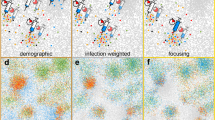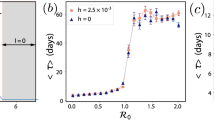Abstract
Mass-vaccination campaigns are an important strategy in the global fight against poliomyelitis and measles. The large-scale logistics required for these mass immunisation campaigns magnifies the need for research into the effectiveness and optimal deployment of pulse vaccination. In order to better understand this control strategy, we propose a mathematical model accounting for the disease dynamics in connected regions, incorporating seasonality, environmental reservoirs and independent periodic pulse vaccination schedules in each region. The effective reproduction number, \(R_e\), is defined and proved to be a global threshold for persistence of the disease. Analytical and numerical calculations show the importance of synchronising the pulse vaccinations in connected regions and the timing of the pulses with respect to the pathogen circulation seasonality. Our results indicate that it may be crucial for mass-vaccination programs, such as national immunisation days, to be synchronised across different regions. In addition, simulations show that a migration imbalance can increase \(R_e\) and alter how pulse vaccination should be optimally distributed among the patches, similar to results found with constant-rate vaccination. Furthermore, contrary to the case of constant-rate vaccination, the fraction of environmental transmission affects the value of \(R_e\) when pulse vaccination is present.











Similar content being viewed by others
References
Agur Z, Cojocaru L, Mazor G, Anderson R, Danon Y (1993) Pulse mass measles vaccination across age cohorts. Proc. Natl. Acad. Sci. 90:11698–11702
Alyward B, Hennessey KA, Zagario N, Olivé J-M, Cochi S (2000) When is a disease eradicable? 100 years of lessons learned. Am J Public Health 90(10):1515–1520
Bacaer N, Ait Dads EH (2012) On the biological interpretation of a definition for the parameter \(R_0\) in periodic population models. J. Math. Biol. 65:601–621
Bacaer N, Guernaoui-Morocco S (2006) The epidemic threshold of vector-borne diseases with seasonality. The case of cutaneous leishmaniasis in Chichaoua. J. Math. Biol. 53:421–436
Bacaër N, Ouifki R (2007) Growth rate and basic reproduction number for population models with a simple periodic factor. Math. Biosci. 210:647–658
Bainov DD, Simeonov PS (1989) Systems with impulsive effect. Ellis Horwood Ltd., Chichester
Bainov DD, Simeonov PS (1993) Impulsive differential equations: periodic solutions and applications. Longman Scientific and Technical, Burnt Mill
Bainov DD, Simeonov PS (1995) Impulsive differential equations: asymptotic properties of the solutions. World Scientific, Singapore
Birmingham ME, Aylward RB, Cochi SL, Hull HF (1997) National immunization days: state of the art. J. Infect. Dis. 175:S183–188
Breban R, Drake J, Stallknecht DE, Rohani P (2009) The role of environmental transmission in recurrent Avian influenza epidemics. PLoS Comput Biol 5(4):e1000346
Bourouiba L, Teslya SL, Wu J (2011) Highly pathogenic Avian influenza outbreak mitigated by seasonal low pathogenic strains: insights form dynamic modeling. J. Theor. Biol. 271:181–201
Browne CJ, Pilyugin SS (2012) Periodic multidrug therapy in a within-host virus model. Bull. Math. Biol. 74:562–589
Burton J, Billings L, Cummings DAT, Schwartz IB (2012) Disease persistence in epidemiological models: the interplay between vaccination and migration. Math. Biosci. 239(1):91–96
Chicone CC (2006) Ordinary differential equations with applications, 2nd edn. Springer, New York
Earn DJD, Rohani P, Grenfell BT (1998) Persistence, chaos, and synchronicity in ecology and epidemiology. Proc R Soc Lond B 265:7–10
Fine PEM, Carneiro IAM (1999) Transmissibility and persistence of oral polio vaccine viruses: implications for the global poliomyelitis eradication initiative. Am J Epidemiol 150(10):1001–1021
Heffernan JM, Smith RJ, Wahl LM (2005) Perspectives on the basic reproductive ratio. J R Soc Interface 2(4):281–293
Kealey AD, Smith? RJ (2010) Neglected tropical diseases: infection, modeling, and control. j health care poor underserved 21:53–69
Kirkilionis M, Walcher S (2004) On comparison systems for ordinary differential equations. J Math Anal Appl 299:157–173
Li J, Blakeley D, Smith? RJ (2011) The Failure of \(R_0\). Comp Math Methods Med 2011 (Article ID 527610)
Liebovitch LS, Schwartz IB (2004) Migration induced epidemics: dynamics of flux based multipatch models. Phys Lett A 332:256–267
Liu J, Zhou Y (2009) Global stability of an SIRS epidemic model with transport related infection. Chaos Solitons Fractals 40(1):145–158
Lloyd AL, Jansen VAA (2004) Spatiotemporal dynamics of epidemics: synchrony in metapopulation models. Math Biosci 188:1–16
Lakshmikantham V, Bainov D, Simeonov P (1989) Theory of impulsive differential equations. World Scientific, Singapore
Losos J (1998) Report of the work group on viral diseases. In: Goodman RA, Foster KL, Trowbridge FL, Figueroa JP (eds) Global disease elimination and eradication as public health strategies. Bull World Health Organ, vol 76(suppl2), pp 94–102
Meng X, Chen L, Wu B (2010) A delay SIR epidemic model with pulse vaccination and incubation times. Nonlinear analysis: real world applications 11(1):88–98
Morens DM, Holmes EC, Davis AS, Taunbenberger JK (2011) Global rinderpest eradication: lessons learned and why humans should celebrate too. J Infect Dis 204(4):502–505
Onyango NO, Müller J (2014) Determination of optimal vaccination strategies using an orbital stability threshold from periodically driven systems. J Math Biol 68(3):763–784
Smith? RJ, Cloutier P, Harrison J, Desforges A (2012) A mathematical model for the eradication of Guinea worm disease. In: Mushayabasa S, Bhunu CP (eds) Understanding the dynamics of emerging and re-emerging infectious diseases using mathematical models, pp 133–156
Smith? RJ, Li J, Gordon R, Heffernan JM (2009) Can we spend our way out of the AIDS epidemic? A world halting AIDS model. BMC Public Health 9(Suppl 1):S15
Shulgin B, Stone L, Agur Z (1998) Pulse vaccination strategy in the SIR epidemic model. Bull Math Biol 60:1123–1148
Terry AJ (2010) Pulse vaccination strategies in a metapopulation SIR model. Math Biosci Eng 7:457–479
Thieme HR (2003) Mathematics in population biology. Princeton University Press, Princeton
van den Driessche P, Watmough J (2002) Reproduction numbers and sub-threshold endemic equilibria for compartmental models of disease transmission. Math Biosci 180:29–48
Wang W, Zhao X-Q (2008) Threshold dynamics for compartmental epidemic models in periodic environments. J Dyn Differ Equ 20:699–717
World Health Organization Regional Offices for Europe and the Eastern Mediterranean (2001) Operation MECACAR: eradicating polio, final report 1995–2000. World Health Organization Regional Office for Europe, Copenhagen, Denmark
World Health Organization (2008) The case for completing polio eradication. Geneva, Switzerland: World Health Organization. Available at: http://www.polioeradication.org/content/publications/thecase_final
Xiao Y, Tang S, Zhou Y, Smith RJ, Wu J, Wang N (2013) Predicting an HIV/AIDS epidemic and measuring the effect of mobility in mainland China. J Theor Biol 317:271–285
Xiao Y, Zou X (2013) Transmission dynamics for vector-borne diseases in a patchy environment. J Math Biol 69(1):113–146
Yameogo KR, Perry RT, Yameogo A et al (2005) Migration as a risk factor for measles after a mass vaccination campaign, Burkina Faso, 2002. Int J Epidemiol 34:556–564
Yang YP, Xiao YN (2010) The effects of population dispersal and pulse vaccination on disease control. Math Comput Model 52:1591–1604
Zhao X-Q (2003) Dynamical systems in population biology. Springer, New York
Zipursky S, Boualam L, Cheikh DO, Fournier-Caruana J, Hamid D, Janssen M, Kartoglu U, Waeterloos G, Ronveaux O (2011) Assessing the potency of oral polio vaccine kept outside of the cold chain during a national immunization campaign in Chad. Vaccine 29(34):5652–5656
Acknowledgments
We are grateful to two anonymous reviewers whose comments greatly improved the manuscript. RJS? is supported by an NSERC Discovery Grant. For citation purposes, note that the question mark in “Smith?” is part of his name.
Author information
Authors and Affiliations
Corresponding author
Rights and permissions
About this article
Cite this article
Browne, C.J., Smith, R.J. & Bourouiba, L. From regional pulse vaccination to global disease eradication: insights from a mathematical model of poliomyelitis. J. Math. Biol. 71, 215–253 (2015). https://doi.org/10.1007/s00285-014-0810-y
Received:
Revised:
Published:
Issue Date:
DOI: https://doi.org/10.1007/s00285-014-0810-y




